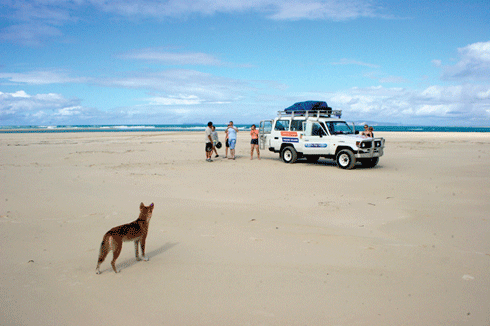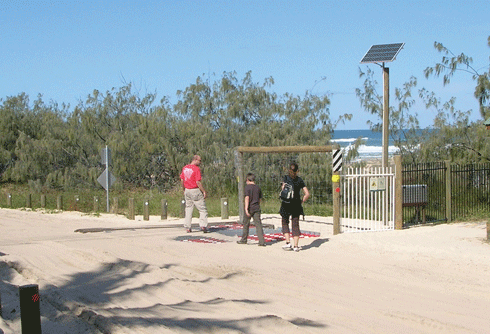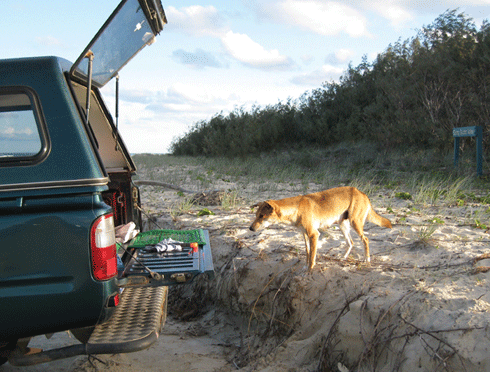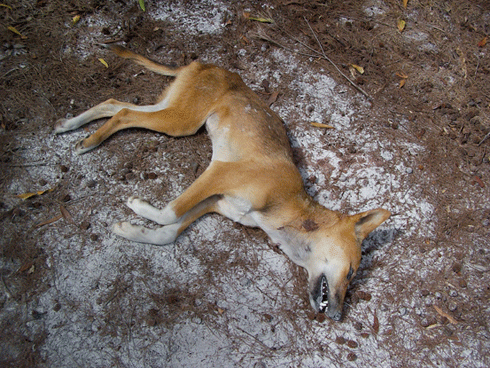
|
Published:
Concerns heightening for Fraser Island’s dingoes
How best to ensure the survival of the last remaining dingoes on Fraser Island is a matter of continuing controversy. Nick Alexander reports from the World Heritage site.

|
|
Around half a million visitors, many from overseas, visit Fraser Island each year. The wild dingo is a major attraction. Credit: Jennifer Parkhurst
|
In July this year the Queensland Minister for Climate Change and Sustainability, Kate Jones, announced a dingo ‘census’ on Fraser Island so that her department could ‘further fine-tune management strategies for a sustainable dingo population, while ensuring public safety’.1
Earlier in the year the department’s controversial dingo management strategy elicited 71 public submissions, mainly from residents, tour operators and animal welfare groups. Most were concerned over the rapidly shrinking dingo population, and what they see as inhumane treatment from the Queensland Parks and Wildlife Service (QP&WS).
Former CSIRO researcher, Dr Laurie Corbett, who advises the QP&WS on their dingo management strategy, was called in to review the current strategy and respond to the public concerns. An authority on the dingo, Corbett recognises the Fraser Island population as one of six in Australia worthy of the National Heritage List, and wrote the recent IUCN’s nomination of the dingo as a Vulnerable species.
Dingoes have been on Fraser Island for at least 1000 years. When the area was nominated by the Australian Government for World Heritage listing in 1991, its dingo population, then between 200 to 300 animals, was believed to be ‘the largest genetically unhybridised population on the east coast of Australia’.2
Domestic dogs had been banned from the island in 1981, thus halting the relatively small amount of genetic ‘introgression’ that had already taken place. After the island was listed as World Heritage, logging was stopped and the entire island was managed as a National Park.
Visitor numbers to Fraser Island today are estimated at around 500 000 people a year, with the thrill of seeing a dingo ‘in the wild’ a major drawcard.
When a young child was mauled by a dingo in January 1994, the media seized on the story, and questions of public safety were raised. There were fears the dingoes were getting out of hand, and orders came from Brisbane for the offending animal to be shot.
During the following six years a further 103 dingoes were reportedly culled – it became standard management practice for the QP&WS to kill any ‘aggressive’ animal or animal that ‘shows no fear of humans’.
When, in 2001, a nine-year-old schoolboy, Clinton Gage, was fatally mauled, there was another media outcry, and a further 32 dingoes were culled within a matter of a few weeks.
Those concerned about the fate of Fraser Island dingoes – including researcher Dr Luke Leung from Queensland University – now fear the population has been reduced to around 100 animals and their genetic viability over the long term is being compromised.

|
|
At Eurong village, tourists wilfully disregard QP&WS signs and walk across an electrified grid which has filled with sand. Credit: Nick Alexander
|
A key principle of the management strategy is that dingoes are regarded as ‘wild, native animals and should be interfered with as little as possible’. Dingoes ‘should be viewed as wild animals and not semi-domesticated camp dogs or wildlife park attractions’. Any dingo ‘identified as dangerous’ is ‘destroyed humanely’ in order to reduce ‘the risk posed to humans to an acceptable low level’.3
However, the practice of culling any ‘problem’ animal can, potentially, dislocate the dingo pack structure by removing adult animals. The pack relies on these elders to maintain the social order, and help teach the younger animals how to hunt.
Tim Rivers, a tour operator who has been involved with visitors to the area for more than 30 years, is alarmed at the now low levels of dingo sightings on the island, and suggests that the official figures of dingo numbers are overstated. He believes many more dingoes have been culled than the QP&WS are prepared to admit, and is concerned the kills have not always been clean and humane. Rivers claims having seen ‘animals with gunshot wounds in shoulders, hindquarters and even facial wounds’.4
Part of the management strategy is to keep dingoes off the beach and away from tourist areas by means of ‘hazing’. This involves attempting to scare dingoes away by shanghai-ing them with pellets. Opponents of the management plan feel this practice is cruel, and consider that it can only add to the dingoes’ mistrust of humans and heighten their antagonism.
Another contentious issue is that of ear-tagging dingoes on the island. Dingo pups as young as four months have been trapped and marked with a tag in their ear. Opponents of this practice consider it cruel and debilitating. The ear sometimes becomes infected and the tag may cause the pup’s ear to flop over. This impedes its ability to discriminate the direction from which a sound is coming – something critical when the pup is learning to hunt for food.

|
|
This young mother of seven pups, her tagged right ear permanently flopped over, searches the beach and tourist vehicles for fish offal. Feeding of dingoes carries a heavy fine. Credit: Nick Alexander
|
In some cases the trapping of an animal in order to tag it has also led to a leg being damaged or broken, further limiting its ability to survive ‘in the wild’.
It is hard to reconcile the ear-tagging and ‘hazing’ of dingoes with the QP&WS’s ‘cardinal principle’ of park management: ‘to provide, to the greatest possible extent, for the permanent preservation of the area’s natural condition and the protection of the area’s cultural resources and values’.5 The activities, apart from their potentially inhumane aspects, are seemingly at odds with the principle of regarding dingoes as wild, native animals and interfering with them as little as possible.

|
|
This young pup was ear-tagged when barely four months old. His ear is permanently damaged. Credit: Jennifer Parkhurst
|
In his 2009 audit of the dingo management strategy, Dr Laurie Corbett defends the issue of tagging so that rangers can identify a ‘problem’ animal easily. He recommends the continued use of slingshots and ‘rat-guns’ as the most effective ‘hazing’ methods, despite the fact many dingoes now recognise the rangers’ vehicles and will flee from them on sight.
Some of the long-term residents of the island point out that there were few dingo problems during the time of Forest Department control. For years, the dingoes were allowed to roam freely through the resorts and small settlements and the feeding of food scraps was actually encouraged. Now the QP&WS has erected a ‘dingo-proof’ fence with electrified ‘cattle grids’ around some of the settlements. The one surrounding the community of Eurong cost $1 million, requires constant maintenance and is still not 100 per cent effective in keeping dingoes out.
The real problem, according to long-time resident Judi Daniel, is the visitors’ lack of common sense. Many of the dingo ‘incidents’ that have led to the destruction of the dingoes involve unsupervised children. ‘Why must a dingo die due to visitors’ stupidity?’ she asks.
Despite the efforts of the pro-dingo alliance, there are still many in the community who consider that ‘the only good dingo is a dead dingo’. The spectre of another attack on a child led one former Queensland postman, writing to the Fraser Coast Chronicle, to argue that: ‘One child’s life is worth more than 100 dingoes.’

|
|
This dingo, with a bullet wound in its neck, was discovered by a tour operator in January last year at Lake Mckenzie. Credit: Caroline Hanger
|
With feelings like this common in the wider community, those who are striving to achieve a better deal for the Fraser Island dingo are facing an uphill battle. Terry Harper, the government’s Senior Director, Marine Parks, has just announced another ‘population dynamics’ study, but this is still in its ‘planning and scoping’ stage, with no time-frame set for its completion.
Researcher Dr Luke Leung believes that, with only six or seven packs left on the island, the time has come for a more ethical and humane approach. For instance, he says, ‘problem’ animals could be relocated from the island to a breeding facility in order to maintain the gene pool of this relatively pure strain of dingo.
In the meantime, Humane Society International has called for an immediate end to the culling of dingoes on Fraser Island and for better education of tourists visiting the island on how to interact with the dingoes.
Nick Alexander, a science communicator and publisher for 30 years, visits Fraser Island each year. He is currently editing a book on the natural history of dingoes.
1 Press release, 21 July 2009, the Hon Kate Jones, Minister for Climate Change and Sustainability.
2 DASETT (1991) ‘Nomination of Fraser Island and the Great Sandy Region by the Government of Australia for inclusion in the World heritage List’.
3 Letter from Dean Wells, Minister for Environment, 24 June 2002.
4 Submission to the review of Management Strategy.
5 Nature Conservation Act 1992, Section 17.

